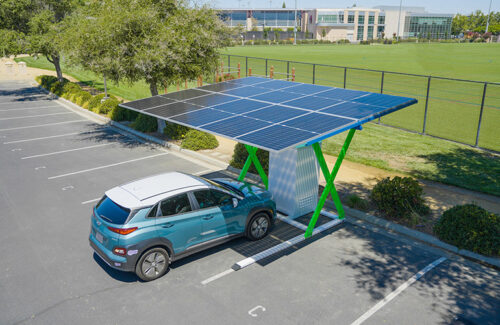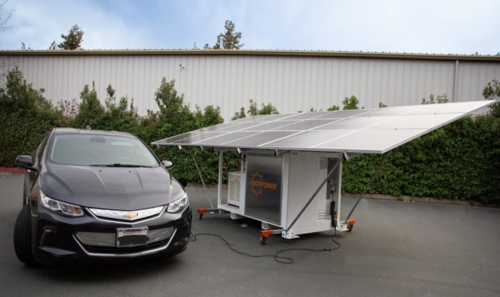Demand for electrifying transit is higher than it’s ever been, yet the process for interconnecting the necessary energy-generating systems to the grid is often long and arduous.
Whether it’s a solar project, EV charger or energy storage system, utilities must assess individual energy project sites to see if the grid requires upgrades to accept the added capacity.

Yotta Energy has entered the off-grid EV charging space with REV. Yotta Energy
“The grid’s just not big enough,” said Tom McCalmont, CEO of Paired Power, which manufactures off-grid EV chargers. “There’s a lot of interest in fully electrifying now across the country, and the politicians are finally excited about it, but they don’t really understand electricity that well and they don’t realize the demand that’s going to put on the grid.”
A study by the Lawrence Berkeley National Laboratory found that more than 600 GW of solar and 400 GW of energy storage projects were stuck in the interconnection queue at the end of 2021. EV chargers, even though individually smaller and more compact than solar and storage systems, must undergo a similar interconnection process, one that can take months or years to complete.
“It’s a difficult process, especially in California,” McCalmont said. “Companies that want to put in 10 or 20 EV chargers in California, that typically requires a new service drop from the utility because your capacity on your existing service drop is not going to be big enough. And that’s a two-year wait.”
But by combining solar, storage and EV chargers –– technologies with long respective interconnection queues –– into single off-grid systems, it’s possible to avoid interconnection altogether.
All-in-one off-grid EV chargers
Manufacturers have recognized the need for more public EV charging and in turn developed packaged solutions to make turnkey off-grid EV chargers. These units come with solar panels, inverters, battery storage, EV chargers and support structures, and they are often able to be disassembled and redeployed. And when a system is off the grid, there is no long wait for utility approval.
Paired Power of Campbell, California, has pioneered off-grid EV technology and has manufactured solar-powered EV charging solutions since 2015, producing hardware used on hundreds of projects. Its newest off-grid product is PairTree, a pop-up solar canopy that uses 5 kW of bifacial solar modules, a 40-kWh battery, a ballasted foundation or ground screws and Paired Power’s proprietary charger, the SunStation.
“The pop-up aspect allows workers to build it standing on the ground, but then raise it up,” McCalmont said. “One of these challenges with traditional solar canopies is the workers are going up and down on scissor lifts all day. It’s very labor-intensive. So being able to stand on the ground, it facilitates a much faster and simpler assembly process, and no lifts.”
The inverter, battery and charger are housed in a metal enclosure. SunStation comes in two models, SunStation HPC (High-Powered Charger) and SunStation Level 2 Charger. HPC is a direct-to-DC, 60-kW EV charger that’s installed on carport or ground-mounted solar projects. And the Level 2 Charger comes standard on PairTree.

The PairTree from Paired Power is a solar canopy and off-grid EV charger in one. Paired Power
BoxPower of Grass Valley, California, is another turnkey off-grid EV charger supplier. It got its start as a Princeton University research project exploring alternatives for diesel generators.
“We thought we’d be working in places where there’s a less-reliable grid internationally, but then quickly saw a huge need domestically, especially in California where we’re based, with the wildfires and the PSPS (public safety power shutoff) events associated with that,” said Anderson Barkow, co-founder and CFO of BoxPower.
The company produces prefabricated, portable off-grid power plants built within shipping containers, which lend themselves to simpler transit and modular design. These solar + storage shipping containers can also be outfitted with EV chargers.
The four primary components of BoxPower’s EV chargers are solar panels, batteries, inverters and the charger itself. Modules can be installed in a single pitch or at a dual tilt on racking attached to the shipping container. BoxPower can link multiple containers together to meet increasing energy demand and the system is outfitted with a software that lets operators monitor and control the system remotely.
Energy storage manufacturer Yotta Energy is also breaking into the off-grid EV charging space with REV.
“It was really seeing an opportunity where we could take some of the technology that we’ve developed here on battery thermal management and knowhow and power conversion,” said Omeed Badkoobeh, CEO of Yotta Energy. “And it started off as a side project. We said, ‘There’s not a lot of people operating in this space, and it seems to be a pretty potential market opportunity.’”
REV comes in two models: REV Core and REV Core XL, which can be installed with 15 to 34 kW of bifacial solar modules and 50 to 300 kWh of lithium-iron phosphate battery storage, respectively. Each uses a 24-kW EV charger, with Core able to charge up to 240 miles and Core XL up to 510 miles daily.
The solar modules are installed in a “butterfly” design, with two sections of panels angled upward off either side of the charger in an east-west orientation. This ensures steadier power production throughout the day, instead of a peak at midday. In addition, REV has an access panel with outlets for 50 amps of emergency backup power.
There are other companies like Beam Global producing solar-powered off-grid EV charging solutions, and with newer entries from Paired Power, Yotta Energy and BoxPower, the space is expanding.
Where is off-grid EV charging needed?

BoxPower produces off-grid EV chargers built into shipping containers. BoxPower
There are many use cases for off-grid EV charging. There are certainly customers in remote locations that want to build charging infrastructure where there is no grid support. Business owners that lease commercial buildings can use off-grid charging, too, because they may be unable to add a permanent charging station and the electrical trenching it requires.
In both cases, it’s likely that the off-grid permitting process is much simpler than trying to tie the chargers to the grid.
“For a lot of installations, it’s going to be ‘de minimis’ –– maybe none at all,” Paired Power’s McCalmont said. “Certainly, in rural locations. Typically, in a lot of AHJs, if it’s a temporary structure, which means it’s designed to be removed or is capable of being removed, no permit is required. We know in some cities they’re not going to be quite that liberal. They’ll probably want a streamlined permit process where they do something like evaluate it structurally.”
Avoiding the interconnection queue and the costs associated with it can make off-grid EV chargers much more affordable. Ampcontrol, an EV-charging optimization software developer, estimates that it costs about $1,000 to connect 1 kW of charging capacity to the grid — and that’s on top of the cost of the chargers themselves.
To recoup costs, some off-grid charger owners choose to monetize the charging services. But manufacturers said other customers like municipalities and national parks that install these chargers in more remote locations where there is no grid infrastructure usually offer charging for free.
Both off-grid and grid-tied chargers will be necessary to meet demand as EVs become more popular. Solar + storage technologies will undoubtedly play a role in that buildout.





Thank you for this article!